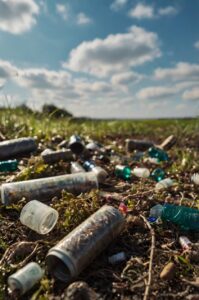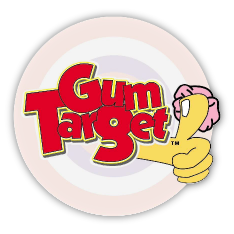Micro-litter is the name for very small waste fragments (broken pieces) that are smaller than 5 millimeters. It can come from various sources, such as plastics and textiles, and, more unusually, chewing gum. Although small pieces might not be very impressive, they are present everywhere in the environment, often invisibly, but with impacts that are definitely real.
There has been significant focus on micro-plastics. On the other hand, gum litter doesn’t get quite much attention, despite being surprisingly common. That small piece of gum that someone spits out on the street doesn’t just disappear. It gradually breaks into smaller and smaller pieces over time, contributing (along with already significant quantities to the micro-litter we now have.
There is a surprising range of sources for micro-litter. There are fibers that are shed from synthetic clothing when it is washed. Or there are further degraded bits of larger plastic items such as water bottles and bags. All of these add to the growing problem of micro-litter in our environment.
The Impact of Micro-Litter
These little pieces often end up in our rivers and, ultimately, oceans. Marine creatures such as fish and turtles may mistake them for food, resulting in digestive problems or death.
Some of these animals fall prey to larger ones, and so on up the food chain. Eventually, this brings it to us. By consuming seafood, humans risk eating micro-particles, which may have adverse health effects.
Micro-litter does the same thing on land, where it contaminates soil and water, affecting the growth of crops and the quality of drinking water. It’s a disturbing cycle in which tiny bits of waste can create huge problems.
Chewing Gum
Gum takes a long time to biodegrade (many years). As gum degrades, its fragments add to the micro-litter already in existence, thus worsening the problem.
When gum lands on a surface, it sticks to that surface, making removal more difficult. This is one reason why cities clean up considerable amounts of gum from streets and public areas each year at a very high cost.
It’s incredible that something as harmless as chewing gum could cause such serious environmental problems. While it’s typically thought of as litter, over the years the combined total of millions of pieces would be quite significant.
How Does Micro-Litter Get Into Our Ecosystems?
Most micro-litter comes from daily human activities. For example, washing clothes causes the shedding of synthetic fibers, and small actions like dropping little bits of waste contribute to a larger problem of litter. But micro-litter is not always due to improper disposal. It can come from industrial sources, such as when larger plastic items break down during manufacturing processes, creating small plastic debris.
Rain and wind are responsible for transporting these particles into our rivers, lakes, and, eventually, the ocean. Another major issue is the failure of wastewater treatment plants to filter out many such pollutants completely before discharging water back into nature.
Microbeads—very small plastic particles found in some scrubs and toothpastes—are a specific case of micro-litter After they go down the drain, they flow into natural bodies of water, where they remain for a long time without decomposing.
 Why Should We Care?
Why Should We Care?
Environmental health is human health, and these concerns eventually come to bear upon our own well-being. By understanding and addressing micro-litter, we help protect ecosystems, which include our food sources, and, most importantly, our own bodies.
Often, tiny particles carry harmful substances like chemicals and toxins. When fish and other sea animals consume these particles, the harmful substances can enter our food chain. Although research into this area is ongoing, the potential health risks make it an issue worth noting.
Addressing micro-litter would save considerable sums of money. Governments and local authorities spend huge amounts of money cleaning up litter, including micro-litter, and investing in more lasting solutions would reduce this expenditure, thus freeing up resources for other needs.
Solutions to the Micro-Litter Problem
Every single one of us can help with this. Doing simple things such as not littering or throwing trash away correctly really can create a huge impact. Every act, no matter how small, helps: Whether you’re throwing gum away responsibly or using reusable bags, it’s a step in the right direction.
At a bigger level, regulations that minimize plastic waste and support recycling can be very powerful. Some places already ban or limit single-use plastics, which might significantly the issue. Private-sector solutions are also visible in things such as biodegradable gums and-friendly packaging.
It’s very important to make people aware of the situation. Micro-litter has impacts, but small actions can lead to big changes. Campaigns and awareness programs are capable of changing attitudes and encouraging a greater number of people to positive action.
Businesses and Policies
The overall footprint can be reduced by developing and promoting sustainable products and reducing plastic dependency. Some companies are already trying to make biodegradable substitutes for conventional plastics and other materials that are problematic.
Governments can pass laws that would cut down the production and use of materials that lead to litter. Policies that favor the use of natural or biodegradable alternatives have a very broad positive reach. Several countries have introduced taxes or outright bans on plastic bags which could be extended to various other sources of micro-litter.
New avenues would open up if industry and policymakers work together, leading to products and processes with minimal litter. Supporting research and encouraging green initiatives is a wise investment in the future, ensuring that generations to come will not be burdened with the issue of litter.
What You Can Do
Be aware. Realizing how cumulative your actions are daily will lead to the ability to change.
Choose natural products instead of those with micro-beads. Reducing demand for these harmful ingredients will help to curb their production. Use products that are packaged, and always dispose of your waste responsibly.
Gum chewers, consider trying biodegradable gums. These options naturally break down more and won’t leave a lasting footprint. If you are concerned about plastic from laundry pods and pellets, look for that do not use plastic.



